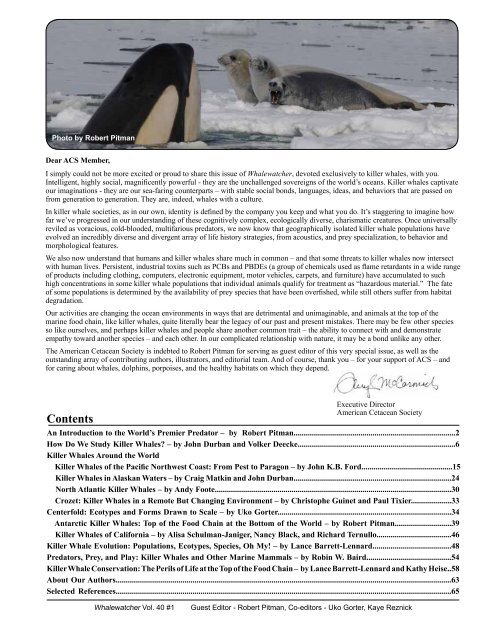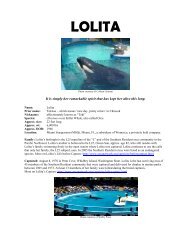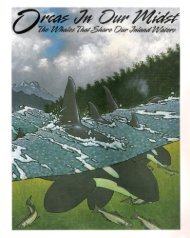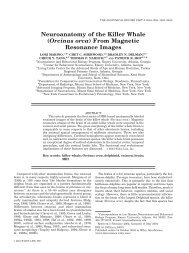Killer Whale: - Orca Network
Killer Whale: - Orca Network
Killer Whale: - Orca Network
You also want an ePaper? Increase the reach of your titles
YUMPU automatically turns print PDFs into web optimized ePapers that Google loves.
Photo by Robert Pitman<br />
Dear ACS Member,<br />
I simply could not be more excited or proud to share this issue of <strong>Whale</strong>watcher, devoted exclusively to killer whales, with you.<br />
Intelligent, highly social, magnificently powerful - they are the unchallenged sovereigns of the world’s oceans. <strong>Killer</strong> whales captivate<br />
our imaginations - they are our sea-faring counterparts – with stable social bonds, languages, ideas, and behaviors that are passed on<br />
from generation to generation. They are, indeed, whales with a culture.<br />
In killer whale societies, as in our own, identity is defined by the company you keep and what you do. It’s staggering to imagine how<br />
far we’ve progressed in our understanding of these cognitively complex, ecologically diverse, charismatic creatures. Once universally<br />
reviled as voracious, cold-blooded, multifarious predators, we now know that geographically isolated killer whale populations have<br />
evolved an incredibly diverse and divergent array of life history strategies, from acoustics, and prey specialization, to behavior and<br />
morphological features.<br />
We also now understand that humans and killer whales share much in common – and that some threats to killer whales now intersect<br />
with human lives. Persistent, industrial toxins such as PCBs and PBDEs (a group of chemicals used as flame retardants in a wide range<br />
of products including clothing, computers, electronic equipment, motor vehicles, carpets, and furniture) have accumulated to such<br />
high concentrations in some killer whale populations that individual animals qualify for treatment as “hazardous material.” The fate<br />
of some populations is determined by the availability of prey species that have been overfished, while still others suffer from habitat<br />
degradation.<br />
Our activities are changing the ocean environments in ways that are detrimental and unimaginable, and animals at the top of the<br />
marine food chain, like killer whales, quite literally bear the legacy of our past and present mistakes. There may be few other species<br />
so like ourselves, and perhaps killer whales and people share another common trait – the ability to connect with and demonstrate<br />
empathy toward another species – and each other. In our complicated relationship with nature, it may be a bond unlike any other.<br />
The American Cetacean Society is indebted to Robert Pitman for serving as guest editor of this very special issue, as well as the<br />
outstanding array of contributing authors, illustrators, and editorial team. And of course, thank you – for your support of ACS – and<br />
for caring about whales, dolphins, porpoises, and the healthy habitats on which they depend.<br />
Contents<br />
Executive Director<br />
American Cetacean Society<br />
An Introduction to the World’s Premier Predator – by Robert Pitman................................................................................2<br />
How Do We Study <strong>Killer</strong> <strong>Whale</strong>s – by John Durban and Volker Deecke..............................................................................6<br />
<strong>Killer</strong> <strong>Whale</strong>s Around the World<br />
<strong>Killer</strong> <strong>Whale</strong>s of the Pacific Northwest Coast: From Pest to Paragon – by John K.B. Ford.............................................15<br />
<strong>Killer</strong> <strong>Whale</strong>s in Alaskan Waters – by Craig Matkin and John Durban..............................................................................24<br />
North Atlantic <strong>Killer</strong> <strong>Whale</strong>s – by Andy Foote.....................................................................................................................30<br />
Crozet: <strong>Killer</strong> <strong>Whale</strong>s in a Remote But Changing Environment – by Christophe Guinet and Paul Tixier....................33<br />
Centerfold: Ecotypes and Forms Drawn to Scale – by Uko Gorter......................................................................................34<br />
Antarctic <strong>Killer</strong> <strong>Whale</strong>s: Top of the Food Chain at the Bottom of the World – by Robert Pitman............................39<br />
<strong>Killer</strong> <strong>Whale</strong>s of California – by Alisa Schulman-Janiger, Nancy Black, and Richard Ternullo.....................................46<br />
<strong>Killer</strong> <strong>Whale</strong> Evolution: Populations, Ecotypes, Species, Oh My! – by Lance Barrett-Lennard.......................................48<br />
Predators, Prey, and Play: <strong>Killer</strong> <strong>Whale</strong>s and Other Marine Mammals – by Robin W. Baird..........................................54<br />
<strong>Killer</strong> <strong>Whale</strong> Conservation: The Perils of Life at the Top of the Food Chain – by Lance Barrett-Lennard and Kathy Heise..58<br />
About Our Authors......................................................................................................................................................................63<br />
Selected References......................................................................................................................................................................65<br />
<strong>Whale</strong>watcher Vol. 40 #1<br />
Guest Editor - Robert Pitman, Co-editors - Uko Gorter, Kaye Reznick







